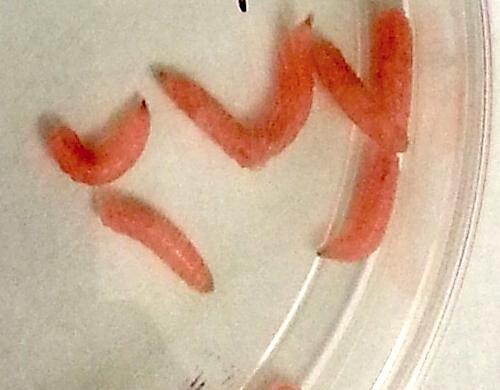In a proof-of-concept study, NC State University researchers show that genetically engineered green bottle fly (Lucilia sericata) larvae can produce and secrete a human growth factor - a molecule that helps promote cell growth and wound healing.
Sterile, lab-raised green bottle fly larvae are used for maggot debridement therapy (MDT), in which maggots are applied to non-healing wounds, especially diabetic foot ulcers, to promote healing. Maggots clean the wound, remove dead tissue and secrete anti-microbial factors. The treatment is cost-effective and approved by the Food and Drug Administration. However, there is no evidence from randomized clinical trials that MDT shortens wound healing times.
With the goal of making a strain of maggots with enhanced wound-healing activity, NC State researchers genetically engineered maggots to produce and then secrete human platelet derived growth factor-BB (PDGF-BB), which is known to aid the healing process by stimulating cell growth and survival.
 Genetically modified green bottle flies produce and secrete a human growth factor that helps wound healing. Credit: Max Scott
Genetically modified green bottle flies produce and secrete a human growth factor that helps wound healing. Credit: Max Scott
Max Scott, an NC State professor of entomology, and colleagues from NC State and Massey University in New Zealand used two different techniques to elicit PDGF-BB from green bottle fly larvae.
One technique utilized heat to trigger the production of PDGF-BB in transgenic green bottle flies. The technique worked - to a point. The human growth factor was detectable in certain structures within the larvae after the larvae were shocked with high heat - a level of 37 degrees Celsius - but PDGF-BB was not detectable in maggot excretions or secretions, making it unworthy of clinical use.
"It is helpful to know that a heat-inducible system can work for certain proteins in the green bottle fly, but the fact that maggots did not secrete the human growth factor makes this technique a non-starter for clinical applications like MDT," Scott said.
The second technique was more successful. Scott and colleagues engineered the flies such that they only made PDGF-BB if raised on a diet that lacked the antibiotic tetracycline. PDGF-BB was made at high levels in the larvae and was found in the excretions and secretions of maggots, making the technique a potential candidate for clinical use.
"A vast majority of people with diabetes live in low- or middle-income countries, with less access to expensive treatment options," Scott said. "We see this as a proof-of-principle study for the future development of engineered L. sericata strains that express a variety of growth factors and anti-microbial peptides with the long-term aim of developing a cost-effective means for wound treatment that could save people from amputation and other harmful effects of diabetes."
source: North Carolina State University